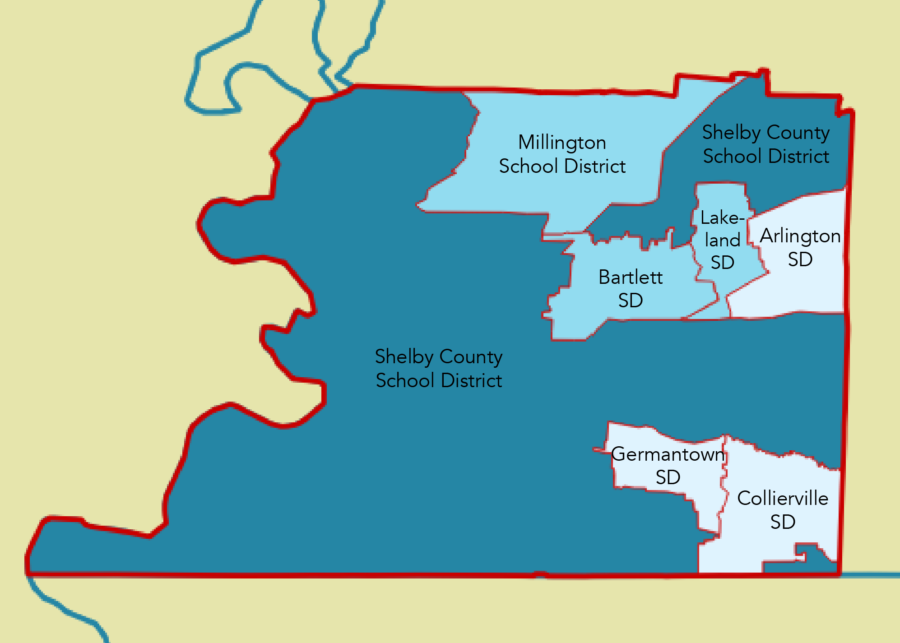This post is written by Jimmie Covington, veteran Memphis reporter with lengthy experience covering governmental, school, and demographic issues. He is a contributing writer with The Best Times, a monthly news magazine for active people 50 and older, where this article is appearing in its May issue.
By Jimmie Covington
Weighted average daily attendance (ADA) numbers for this school year will again result in a shift in county funding from Shelby County Schools and other publicly funded schools in the county district to five of the six suburban school systems.
Overall, the Shelby County schools will receive $2.39 million less than they would have if last year’s percentages had continued. That amount, from county property and wheel tax funds, will go to the suburban districts.
The Collierville school district will be the biggest gainer with a $1.53 million increase. The Millington district had a small ADA decline and will receive $128,178 less than last year’s percentages would have provided.
Dr. Joris Ray, county schools superintendent, filed the school districts’ weighted full-time equivalent average daily attendance (WFTEADA) figures with Shelby County Trustee Regina Newman in March. The Tennessee Department of Education had certified the numbers.
In addition to the property and wheel tax funding, the county trustee uses the percentages to divide revenue from schools’ one-half share of the 2.25 percent countywide local option sales tax. The one-half share totaled $158.59 million in the last fiscal year.
The weighted ADA percentages are also used to divide some other county and state monies among school districts.
Memphis schools are in the county district.
Last year, former County Mayor Mark Luttrell recommended and the County Commission in office at the time capped the total amount schools could receive from the county property tax and the county’s wheel tax allocated to schools at $427,259,000, which was $7.78 million more than the previous year’s $419,471,000.
By law, the commission cannot limit the revenue from the portion of the property tax rate it sets for schools. However, it can limit the amount of wheel tax revenue it gives to schools and has used this power to limit the total that schools receive from the two tax sources. The practice of capping the amount that schools received began under former County Mayor A C Wharton in 2007.
School supporters at the time considered it to be an anti-schools move.
Whether new County Mayor Lee Harris and new commissioners in office will continue this practice is unclear.
Calculations show the school districts will receive these property tax and wheel tax revenue totals under the new WFTEADA percentages:
Shelby County and other — $329,373,963
Arlington — $14,142,272
Bartlett — $26,490,058
Collierville — $26,874,591
Germantown — $18,115,781
Lakeland — $4,913,478
Millington — $7,348,854
The new WFTEADA percentages (with last year’s percentages in parentheses) are:
Shelby and other – 77.09 (77.65)
Arlington – 3.31 (3.24)
Bartlett – 6.20 (6.19)
Collierville – 6.29 (5.93)
Germantown – 4.24 (4.16)
Lakeland – 1.15 (1.08)
Millington – 1.72 (1.75)
In the 2014-15 school year, the first year the six suburban districts were in operation, the weighted ADA was 79.25 county and other and 20.75 suburban. This year it is 77.09-22.91
The weighted average daily attendance numbers in the school districts this year (with last year’s numbers in parentheses) are:
Shelby and other – 134,753 (135,306)
Arlington – 5,782 (5,643)
Bartlett – 10,836 (10,795)
Collierville – 11,000 (10,348)
Germantown – 7,405 (7,250)
Lakeland – 2,017 (1,882)
Millington – 2,997 (3,048)
Total – 174,790 (174,332)
The weighted ADA numbers are higher than regular enrollment and attendance numbers. Under the state’s funding approach students are “weighted” according to the grade and programs in which they are enrolled.
Students at certain grade levels and in programs such as special education and career and technical education are “weighted” at higher than 1 for funding purposes. The enrollment numbers for this year will be available in the “report cards” the state will issue for each school district later this year.
**
Join us at the Smart City Memphis Facebook page for daily articles, reports, and commentaries relevant to Memphis.






Bring vouchers to the middle and upper-middle class, once that happens then we will begin to end the shift education dollars to the suburbs. If the State of TN offered vouchers to those in the middle and middle upper incomes, families would stop bolting for the burbs to raise their children. Families leave Memphis to move to the suburbs because of their good schools. Over time, property taxes in Memphis would decline significantly as the vacant lots would be developed as many more families would choose to stay since they could choose where they want their children educated. Crime should also decline as neighborhoods would begin to stabilize with many new homeowners who will take ownership in and help self police their neighborhoods.